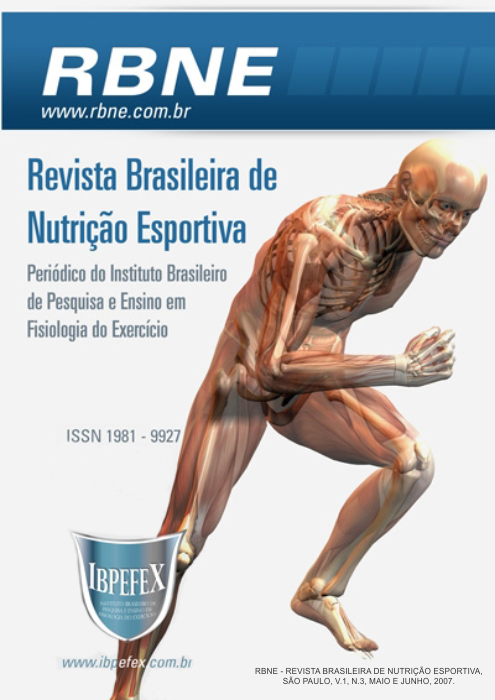Obesity as limitante factor of the physical aptitude in daily pay-pubescent children
Abstract
Previously it was characterized that the excess of corporal weight can constitute a limitante factor of the cardiovascular capacity of obsess children, however, in Brazilian children this little was studied. In this perspective, this studyit evaluated if the obesity can limit the physical capacity of children in pertaining to school age (the 09 10 years), of two schools of São Paulo. The children had been randomized in two groups: children with corporal weight inside of the band of normality predicted for the age and children above of the weight predicted for the age (obesity). Later, the subjects had been categorized by the respective gender (male and female). In both the groups had been proceeded with analyze anthropometric and were applied the test of aerobic capacity 20 m Shuttle-run test for determination of the values of maximum consumption of oxygen (VO2max). Our results demonstrate that significant when pertaining to school obese with pertaining to school with normal weight are compared. This I not only argued what he is obvious, but the importance if knowing a method’s that can be used by teacher of physical education to determine that the obesity children has small maximum consumption of oxygen (VO2max). One concludes that the obese children when she practices any that is activity the transport of volume of oxygen always lesser will be compared with the children who are inside of normality.
References
Deurenberg, P.P.; e colaboradores. Classificação do percentual de gordura de crianças e adolescentes de 7 a 17 anos. 1999.
Drachler, M.L.; e colaboradores. Fatores de risco para sobrepeso em crianças no Sul do Brasil; Cad. Saúde Pública vol. 19. nº4 Rio de Janeiro July/Aug, 2003.
Drinkard, B.; McDuffie, J.; McCann, S.; Uwaifo, G.I.; Nicholson, J.; Yanovski, J.A. Relationships between walk/run performance and cardiorespiratory fitness in adolescents who are overweight. Phys Ther. 81: 1889–1896, 1986
Duarte, C.R.; Duarte, M.F.S. Capacidade aeróbica em escolares de 10 a 18 anos: V02 e PWC 170. Revista Brasileira de Ciência e Movimento, 3(3): 17- 25, 1989.
Epstein, L.H.; Coleman, K.J., Myers, M.D. Exercise in treating obesity in children and adolescents. Med Sci Sports Exerc. 1996; 28: 428–435.
Epstein, L.H.; Goldfield, G.S. Physical activity in the treatment of childhood overweight and obesity: current evidence and research issues. Med Sci Sports Exerc. 1999; 31(suppl): S553–S559
Foss, M.L.; Keteyian, S.L. Bases fisiológicas do exercício e do esporte (6ª. Edição). Editora Guanabara Koogan, 2000, p. 83.
Goran, M.; Fields, D.A.; Hunter, G.R.; Herd, S.L.; Weinsier, R.L. Total body fat does not influence maximal aerobic capacity. Int J Obes Relat Metab Disord. 2000; 24: 841–848
Léger, L.A.; Lambert, J. A maximal multistage 20-m shuttle run test to predict V02 max. European Journal of Applied Physiology, 49: 01-12, 1982.
MacArdle, W.D.; Katch, F.I.; Katch, V.L. Fisiologia do Exercício: energia, nutrição e desempenho humano (4ª. Edição). Editora Guanabara Koogan, 1996, p. 577.
Maestri, M.; Fiamoncini, R. L. Perfil Antropométrico de crianças na idade de 8 a 10 anos. http://www.efdeportes.com/ Revista Digital - Buenos Aires - Año 11 - N° 97 - Junio de 2006
- NCHS. Padrões de referência. Division of Health Examination Statistics. Ohio, 2000.
- Neto, A.S.; e colaboradores. VO2max e composição do corpo durante puberdade: comparação entre as crianças que participam no treinamento sistemático do futebol e as crianças que não treinam. Revista Brasileira de Cineantropometria e Desempenho Humano, vol. 9 (2), 159-164, 2007.
- Norman, A.C.; e colaboradores. Influence of Excess Adiposity on Exercise Fitness and Performance in Overweight Children and Adolescents, American Academy of Pediatrics, 2006.
- Slaughter, M.H.; e colaboradores. Skinfold equations for estimation of body fatness in children and youth. Human Biology. Gols, p.709-723, 1998.
- Viebig, R.F.; Patton, C.T. Nadadores mirins competitivos: adequação do estado nutricional. http://www.efdeportes.com/ Revista Digital - Buenos Aires - Año 11 - N° 96 - Mayo de 2006
Authors who publish in this journal agree to the following terms:
- Authors retain the copyright and grant the journal the right of first publication, with work simultaneously licensed under the Creative Commons Attribution License BY-NC which allows the sharing of the work with acknowledgment of the authorship of the work and initial publication in this journal.
- Authors are authorized to enter into additional contracts separately for non-exclusive distribution of the version of the work published in this journal (eg, publishing in institutional repository or book chapter), with acknowledgment of authorship and initial publication in this journal.
- Authors are allowed and encouraged to post and distribute their work online (eg, in institutional repositories or on their personal page) at any point before or during the editorial process, as this can bring about productive change as well as increase impact and impact. citation of published work (See The Effect of Free Access).






